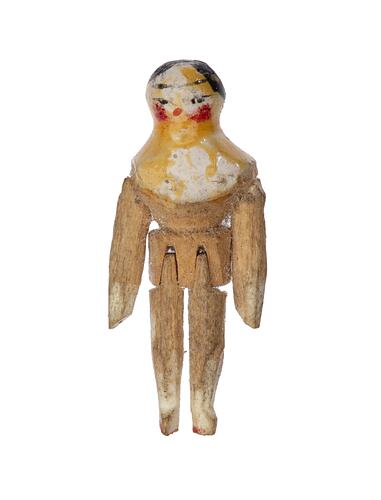Summary
Tiny wooden peg doll, just 9mm tall, housed in a maroon-coloured Bakelite plastic container. The doll is believed to date from around the 1880s and was collected during a 'grand tour' of Europe in the late 19th century by Henry St John Somerset, grandfather of the donor, and passed onto his son Sir Henry Beaufort Somerset, a former Trustee of the National Museum of Victoria. Sir Henry's daughter, who has held the doll since 1940, is the donor.
Although the doll is a simple, hand-made construction, peg wooden dolls (also known as Dutch dolls) originated as lathe-turned dolls in the alps of northern Italy during the 19th century. Peg wooden dolls were also made in the Netherlands and Germany. They were sold undressed so that children could make their own clothing to dress the doll.
Physical Description
Peg doll made of wood. The head and shoulder area have been painted white. Short black hair; eyebrows and eyes have been painted onto the face, with a red nose and blush colour applied to cheeks. Yellow stain over the face and shoulders. Wooden pegs at the joints of the arms and legs enable movement of the limbs. The peg doll is stored in a round maroon coloured Bakelite container between two round white fibre protective pads. The container has an art deco style lid with arrows indicating which way to twist open. It was possibly a pharmaceutical container.
More Information
-
Collecting Areas
-
Acquisition Information
Donation from Mrs Susan Morgan, 23 Apr 2012
-
Original Owner
Mr Henry S. Somerset, Greater Melbourne, Victoria, Australia, 1895 - 1910
-
User
Mrs Susan Morgan, Malvern, Greater Melbourne, Victoria, Australia, 1940 - 2012
-
Inscriptions
Printed on inside of lid: '10'. Printed on top of lid: 'Vasano / Schering'.
-
Classification
-
Category
-
Discipline
-
Type of item
-
Overall Dimensions
5 mm (Width), 3 mm (Depth), 9 mm (Height)
Measurements for doll.
-
Overall Dimensions
15 mm (Height), 36 mm (Outside Diameter)
Measurements of case.
-
Keywords



